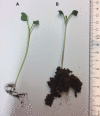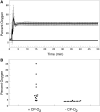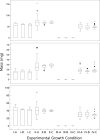An Oxygen Delivery Polymer Enhances Seed Germination in a Martian-like Environment
- PMID: 32196355
- PMCID: PMC7368388
- DOI: 10.1089/ast.2019.2056
An Oxygen Delivery Polymer Enhances Seed Germination in a Martian-like Environment
Abstract
Critical to the success of establishing a sustainable human presence on Mars is the ability to economically grow crop plants. Several environmental factors make it difficult to fully rely on local resources for agriculture. These include nutrient sparse regolith, low and fluctuating temperatures, a high amount of ultraviolet radiation, and water trapped locally in the form of ice or metal oxides. While the 96% CO2 martian atmosphere is ideal to support photosynthesis, high CO2 concentrations inhibit germination. An added difficulty is the fact that a vast majority of crop plants require oxygen for germination. Here, we report the production of a polymer-based oxygen delivery system that supports the germination and growth of cress seeds (Lepidium sativum) in a martian regolith simulant under a martian atmosphere at 101 kPa. The oxygen-donating system is based on a low-density lightly cross-linked polyacrylate that is foamed and converted into a dry powder. It is lightweight, added in low amounts to regolith simulant, and efficiently donates enough oxygen throughout the volume of hydrated regolith simulant to fully support seed germination and plant growth. Germination rates, plant development, and plant mass are nearly identical for L. sativum grown in 100% CO2 in the presence of the oxygen-donating lightly cross-linked polyacrylate compared with plants grown in air. The polymer system also serves to protect root structures and better anchors plants in the regolith simulant.
Keywords: Biological life support; Colonization; Extraterrestrial crops; Plant growth..
Conflict of interest statement
No competing financial interests exist.
Figures










References
-
- Abo Gamar M.I., Kisiala A., Emery R.J.N., Yeung E.C., Stone S.L., and Qaderi M.M. (2019) Elevated carbon dioxide decreases the adverse effects of higher temperature and drought stress by mitigating oxidative stress and improving water status in Arabidopsis thaliana. Planta 250:1191–1214 - PubMed
-
- Ainsworth E.A. and Lemonnier P. (2018) Phloem function: a key to understanding and manipulating plant responses to rising atmospheric [CO(2)]? Curr Opin Plant Biol 43:50–56 - PubMed
-
- Ainsworth E.A., Yendrek C.R., Skoneczka J.A., and Long S.P. (2012) Accelerating yield potential in soybean: potential targets for biotechnological improvement. Plant Cell Environ 35:38–52 - PubMed
Publication types
MeSH terms
Substances
LinkOut - more resources
Full Text Sources
Miscellaneous
